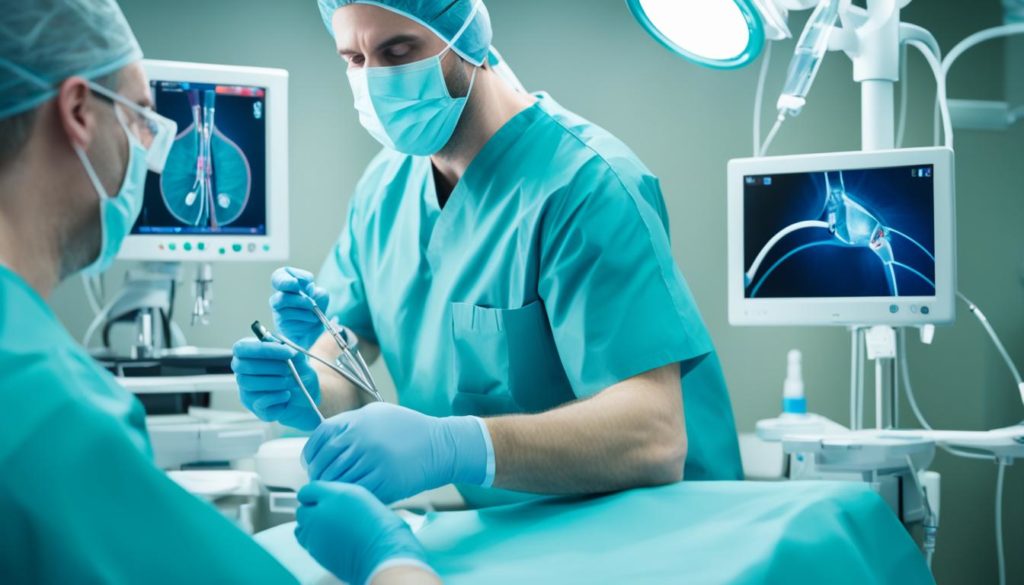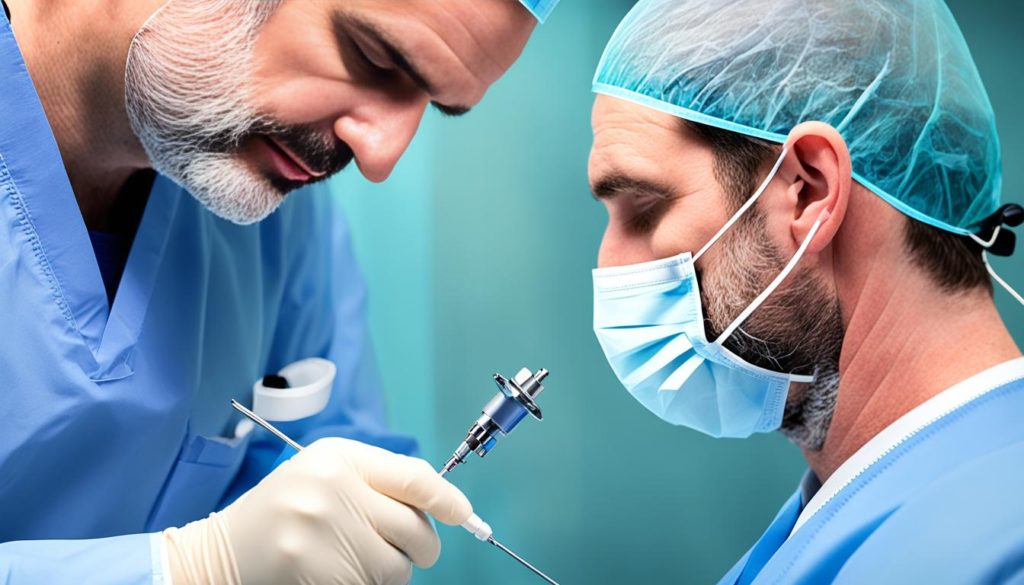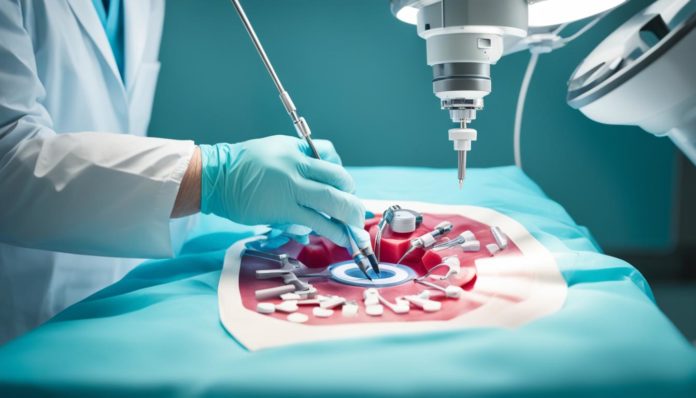Did you know that minimally invasive prostate surgery leads to a much quicker recovery? It’s almost twice as fast as the recovery from traditional open surgery. This fact is a game-changer in the world of advanced prostate cancer procedures. It shows how far we’ve come in improving prostate health.
Laparoscopic radical prostatectomy is at the forefront of battling non-metastatic prostate cancer. It’s done through small cuts, which means less harm to nearby tissue. The method uses special tools and a camera to remove the prostate gland accurately.
After the surgery, patients might face some bruising and swelling. But these usually get better in a few weeks. They’ll deal with pain and need a temporary urinary catheter too. Over time, many see their urinary control and sexual function return. This success proves the surgery’s value. Keeping an eye on PSA levels afterward is crucial. It helps ensure recovery is on track and checks if the cancer comes back.
Key Takeaways
- The recovery time for minimally invasive prostate surgery is nearly twice as fast compared to traditional open surgery.
- Laparoscopic radical prostatectomy involves removing the prostate gland through small incisions.
- Postoperative care is critical for addressing bruising, swelling, and pain management.
- Patients often regain urinary control and sexual function over time.
- Regular follow-up care and PSA level monitoring are essential for long-term recovery and cancer recurrence detection.
What Is Laparoscopic Prostate Cancer Surgery?
Laparoscopic prostate cancer surgery is a minimally invasive method. It’s for taking out the prostate gland in patients with localized prostate cancer. Using small cuts and special tools, this approach, including laparoscopic prostatectomy, sometimes involves robotic help. It aims for successful cancer treatment with fewer problems.

Definition and Overview
Laparoscopic prostatectomy uses a laparoscope, a thin tube with a light and camera, to help the surgeon. In certain cases, robotic systems help the surgeon make precise moves. These methods are advanced cancer treatments that focus on the patient’s recovery and comfort.
How It Differs from Open Surgery
Laparoscopic prostatectomy makes smaller cuts than open surgery. This means less blood loss, less pain after the surgery, and quicker healing times. So, these less invasive ways are now more popular with both patients and doctors. They offer benefits both right after the surgery and in the long run.
| Aspect | Laparoscopic Surgery | Open Surgery |
|---|---|---|
| Incision Size | Small ( | Large (5-10 inches) |
| Recovery Time | Quicker | Slower |
| Blood Loss | Less | More |
| Pain Level | Reduced | Higher |
| Use of Technology | Laparoscope and potentially robotics | Manual |
As shown, laparoscopic and open surgeries differ greatly in treating prostate cancer. The minimally invasive approach is better for patient outcomes. With robotic prostatectomy’s growth, these methods are now top choices for prostate cancer treatment.
Benefits of Minimally Invasive Prostate Surgery

Minimally invasive surgery, like laparoscopic and robotic methods, has many advantages. These benefits are key for faster recovery and better results. Patients usually notice several positive changes.
Quicker Recovery Time
Laparoscopic surgery helps patients recover much quicker. They get back to their daily lives faster than with open surgery. This is mainly because the cuts are smaller and there’s less damage to the body.
Reduced Blood Loss
With minimally invasive techniques, there’s much less blood loss. Robotic surgery lets doctors work with great precision. This means there’s a smaller chance of needing a blood transfusion. This makes the surgery safer and more comfortable for patients.
Lower Risk of Complications
Laparoscopic methods come with fewer complications when compared to traditional surgery. Patients feel less pain afterwards and spend less time in the hospital. Robotic surgery also lowers the risk of infection and other issues due to its accuracy.
Comparative Benefits:
| Benefits | Open Surgery | Minimally Invasive Surgery |
|---|---|---|
| Recovery Time | Longer | Quicker |
| Blood Loss | Higher | Lower |
| Risk of Complications | Higher | Lower |
| Hospital Stay | Longer | Shorter |
Robotic Prostatectomy: The Gold Standard
Robotic prostatectomy is the top choice for advanced prostate cancer surgery. It uses robots to help surgeons work with great accuracy. Patients often prefer this method.
The Procedure Explained
A surgeon controls robotic arms through a console. These arms have tiny tools and a camera for seeing things clearly. This allows the surgeon to work with precision.
This method is better than old-school surgeries. It offers more control and accuracy.
Advantages over Traditional Methods
Robotic prostatectomy is better than open or laparoscopic surgery in many ways:
- It causes much less bleeding.
- It leaves smaller scars.
- People recover faster and can go back to their usual activities quicker.
- There’s less pain and discomfort after surgery.
These benefits make robotic prostatectomy a popular choice among doctors and patients.
Patient Outcomes and Success Rates
Studies show robotic prostatectomy’s success rates are high, similar to traditional surgery. Patients often do well after surgery. They have fewer problems and shorter hospital stays.
Thanks to its precision, robotic surgery is great at controlling cancer over the long term. It’s now a leading technique in the United States for treating prostate cancer.
Who Is a Candidate for Laparoscopic Prostate Cancer Surgery?
Finding the right people for laparoscopic prostate cancer surgery is key. It all starts with a detailed check-up before surgery. The aim is to pick out those whose cancer is still inside the prostate. It shouldn’t have spread to other parts.
Preoperative Evaluation
A deep dive before surgery is essential. It includes checking PSA levels and studying prostate biopsy results. Checking other vital diagnostic data is also key. Understanding these details helps identify who’s right for laparoscopic prostatectomy candidacy.
Factors Influencing Eligibility
Many things play into who can get prostate cancer treatment. Key points to think about include:
- Overall health of the patient
- How far the cancer has spread, especially to lymph nodes
- Any other health issues that might make surgery harder
- Estimating if the cancer might spread, seen by checking lymph nodes
Patients whose cancer hasn’t spread far might do really well with laparoscopic methods. This shows why careful checking before surgery is so crucial.
In the end, deciding if laparoscopic prostatectomy is a fit depends on thorough diagnostic checks and health status. Taking a close look at these details helps find the best path for patients looking for effective prostate cancer treatment options.
Preparing for Laparoscopic Prostatectomy
Getting ready for laparoscopic prostate cancer surgery is key. You’ll first meet your surgeon to talk about the surgery. They’ll review your medical history to see if you’re a good fit. You’ll also discuss how robotic prostatectomy planning can be tailored for you.
A detailed physical exam will check if you’re healthy enough for surgery. You must follow a special diet and not eat before surgery. Your doctor will go over your meds. They might stop some to lower surgery risks.
Learning about care after surgery is crucial for healing well. You’ll learn how to manage a catheter and what to expect during recovery. This info eases discomfort and speeds up healing.
- Consultation with your surgeon to discuss the procedure and robotic prostatectomy planning.
- Physical examination to evaluate your overall health status.
- Dietary guidelines to be followed strictly before surgery.
- Medication review and possible cessation of risk-enhancing drugs.
- Patient education regarding postoperative care and recovery.
By taking these steps seriously, you’re making sure you are ready. This prep leads to the best results from your prostate cancer surgery.
What to Expect During Surgery and Hospital Stay
Getting a laparoscopic prostatectomy means going through several key steps and receiving close attention after the surgery.
Surgical Steps
Anesthesia is given first to keep you comfortable and still. Next, surgeons make a few small cuts in your belly. They then use special tools to take out the prostate carefully, causing little harm to nearby areas.
During the operation, surgeons use the latest imaging technologies. This helps them see better and remove the prostate accurately. After taking out the prostate, they sew up the cuts neatly. This helps you heal faster with less scarring.
Immediate Postoperative Care
Right after the surgery, taking good care of you is crucial. This includes managing pain, preventing infection, and keeping an eye on your vital signs. They also put in a catheter to help with urine flow. It stays in for about 1 to 2 weeks after surgery. During your hospital stay, getting up and moving soon is key for a speedy recovery.
| Postoperative Care | Duration |
|---|---|
| Pain Management | Immediate to Several Days |
| Urinary Catheter Maintenance | 1 to 2 Weeks |
| Hospital Stay | Typically 1 to 2 Days |
| Early Mobilization | First 24 Hours |
Typically, you won’t stay long in the hospital after a prostate surgery. Most people leave a day or two later. This depends on how well they’re recovering and if there are any complications.
Recovery at Home After Laparoscopic Prostate Surgery
Recovering at home after laparoscopic prostatectomy is key for a good outcome. It’s important for the patient’s long-term health. Following doctor’s advice for managing pain and caring for the urinary catheter helps a lot.
Pain Management
Pain management involves prescribed medications and over-the-counter drugs. Patients must follow their doctor’s advice on taking these medications. This minimizes discomfort. Using relaxation techniques and moving gently also helps in managing pain.
Urinary Catheter Care
Proper care for the urinary catheter is important to avoid infections. Patients should keep the catheter area clean and dry. They must follow their doctor’s instructions on catheter care. Reporting any signs of infection right away is crucial.
Gradually getting back to normal activities is also vital. This includes following rules about lifting and how much you move around. It helps in a smoother recovery after the surgery.
Common Risks and Side Effects
Laparoscopic prostate cancer surgery is mostly safe. But understanding the risks is very important. Knowing and handling these risks helps achieve better results.
Short-term Risks
Short-term risks can include reactions to anesthesia, bleeding, blood clots, and infections. These risks are similar to those in any major surgery. It’s important that doctors watch these closely.
Long-term Side Effects
Long-term side effects can really affect your life. The most common problems are urinary incontinence and erectile dysfunction. Dealing with these issues needs good education and support.
Managing Complications
To manage complications well, we use preventive steps and intervention after surgery. Treatments to help with urinary and sexual health are key. They help improve patient results and lessen the surgery’s impact on life.
| Complication | Preventative Measures | Postoperative Interventions |
|---|---|---|
| Infection | Antibiotic Prophylaxis | Postoperative Antibiotics |
| Blood Clots | Compression Stockings | Anticoagulant Therapy |
| Urinary Incontinence | Surgeon Expertise | Pelvic Floor Exercises |
| Erectile Dysfunction | Nerve-Sparing Techniques | Medication and Therapy |
Post-Surgery Follow-up and Monitoring
After surgery, following up and monitoring is key for prostate cancer care. It’s important to catch issues early. This helps patients stay healthy in the long run.
PSA Testing
Checking PSA levels after a prostatectomy is critical. It can show if the cancer might be coming back. For the first few years, tests are done often. If PSA levels go up, it might mean more checks or treatments are needed. Keeping an eye on PSA helps doctors make sure the treatment plan is working.
Regular Check-ups
Seeing the doctor regularly is a must after prostate surgery. It lets doctors see how the recovery is going. They can also deal with side effects and check if you’re following health advice. These visits quickly catch any problems, helping you stay healthy for a long time.
Patient Stories and Success Cases
Hearing prostate cancer survivor stories can be empowering for those facing this challenge. These stories show the journey from diagnosis to recovery. They highlight the success and personal impact of laparoscopic surgery.
“I was diagnosed with prostate cancer two years ago and underwent a laparoscopic prostatectomy,” shares Paul in one of the detailed survivor stories. “After my surgery, I experienced a relapse. The support groups were crucial for my mental well-being, and integrative medicine helped me adopt a more positive mindset.”
People like Paul stress the importance of sharing experiences. They highlight it can provide hope and direction to others on similar paths. After his setback, Paul leaned on mindfulness and radiation therapy, which led to his recovery. His story showcases the power of modern medicine combined with strong support.
These stories also show the benefits of laparoscopic surgeries. They lead to faster recovery and fewer complications. To learn more about Paul’s journey and read other survivor stories, click here.
Choosing the Right Prostate Surgery Specialist
Choosing the right prostate surgery specialist is crucial for a successful operation. Their experience, especially the number of surgeries they’ve done, greatly impacts their skill. In this part, we talk about what to look for in a surgeon.
Importance of Surgeon Experience
Experience really matters in prostate surgery. Surgeons with a lot of experience have better skills and outcomes for their patients. They’ve done many surgeries and know how to handle complex situations with fewer complications.
What to Look for in a Specialist
When looking for a surgeon, consider these points:
- Track Record: Look at their history of successful surgeries and how their patients recovered.
- Patient Testimonials: Reviews can give you insight into how the surgeon treats patients.
- Technological Access: Using the latest technology can lead to better surgery outcomes.
- Research Engagement: Being involved in research shows they keep up with new treatments.
- Personalized Care: It’s important they listen and tailor the care to each patient.
In summary, choosing a prostate surgeon requires careful research and thought. Focus on their experience, success record, and how they use technology. This helps patients make choices that improve their care.
Conclusion
The journey to treat prostate cancer is complex. It demands precision, dedication, and deep knowledge for the best outcomes. Choosing laparoscopic surgery for prostate cancer is a big step. It brings many benefits like faster healing and fewer complications. With a good understanding of the process, benefits, and risks, patients can make better choices and get ready for their journey.
It’s crucial to know how important expert knowledge is for successful results. Recovery is easier with an experienced surgeon who specializes in minimally invasive methods, like robotic prostatectomy. This advanced practice leads to the best outcomes for patients. It highlights the need for skilled surgery for prostate health.
Ultimately, making informed choices, preparing well, and selecting a skilled surgeon are the keys to a successful prostate cancer treatment. Armed with knowledge, patients can face their treatment with confidence. They aim for a better health and life quality. Education and expert care are essential in tackling prostate cancer effectively.
FAQ
What is laparoscopic prostate cancer surgery?
Laparoscopic prostatectomy is a surgery to remove the prostate gland. It’s done to treat prostate cancer that hasn’t spread. The method uses small cuts for surgery tools and a camera. This helps the surgeon see and precisely remove the prostate.
How does laparoscopic prostatectomy differ from open surgery?
It’s different because it uses tiny cuts and special instruments. Robot assistance might be used too. Compared to open surgery, it means less blood loss, quicker healing, and less pain afterwards.
What are the benefits of minimally invasive prostate surgery?
The surgery offers several benefits. Patients recover faster, lose less blood, and have a shorter hospital stay. There’s also less pain after surgery and a lower risk of problems.
What is robotic prostatectomy?
Robotic prostatectomy uses robots to aid surgery and improve precision. Surgeons control robotic arms to remove the prostate. This causes less damage to surrounding tissue and increases accuracy.
Who is considered a candidate for laparoscopic prostate cancer surgery?
Candidates are those with cancer contained in the prostate. They’re picked after tests like PSA levels and biopsies. Overall health is also considered.
How should I prepare for laparoscopic prostatectomy?
Preparation includes talking to your doctor, changing your diet, and reviewing medicines. You might stop some meds and not eat before surgery. Learning about care after surgery is key too.
What can I expect during surgery and the hospital stay?
You’ll be asleep under anesthesia. The surgeon then makes small cuts for the tools. After, care focuses on pain, avoiding infection, and a catheter for 1 to 2 weeks. The hospital stay is usually short.
What should I know about recovery at home after laparoscopic prostatectomy?
At home, manage pain with medicine and take care of the catheter. Avoid heavy lifting. Follow your doctor’s advice on getting back to normal activities.
What are the common risks and side effects of laparoscopic prostatectomy?
Risks include issues with anesthesia, bleeding, clots, and infections. Urinary incontinence and erectile dysfunction might occur later. There are ways to lower these risks during and after surgery.
How is post-surgery follow-up and monitoring conducted?
Follow-up means regular PSA tests to check for cancer return. Visits with your doctor help with healing, side effect management, and overall health.
Are there any success stories or patient testimonials for laparoscopic prostate cancer surgery?
Many patients have seen great results and share their stories. They talk about the importance of skilled care, advanced methods, and strong support in their recovery.
How should I choose the right prostate surgery specialist?
Choose a specialist based on their experience and the number of surgeries they’ve done. Look for patient reviews and if they use the latest tech. A researcher who offers tailored care is a good sign too.


